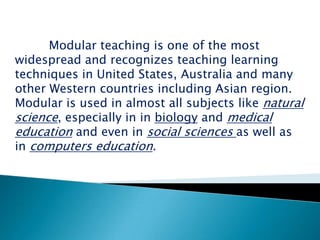
Presentation of modular approach
- 1. Introduction:- Modular teaching is one of the most widespread and recognizes teaching learning techniques in United States, Australia and many other Western countries including Asian region. Modular is used in almost all subjects like natural science, especially in inbiology and medicaleducation and even in social sciencesas well as in computers education.
- 2. …… All kinds of subjects are being taught through modules. It is a recent development based on programmed learning; a well established and universally recognized phenomenon. It considering the individual differences among the learners which necessitate the planning for adoption of the most appropriate teaching techniques in order to help the individual grow and develop at her/his own pace.
- 3. A MODULE IS……………………… A module is a specific type of learning resource. Essentially self contained Self instructional package Self paced learning according to pupils’ need and ability. Cover either single element or a group of content elements of subject matter. or area of skill. It is a recent development based on Programmed instruction.
- 4. “Module is a unit of work in a course of instruction that is virtually self-contained and a method of teaching that is based on the building up skills and knowledge in discrete units” Definition…….
- 5. CHARECTERISTICS OF MODULE It should be independent. Self-contained. Self instructional. Well defined. Clearly defined objectives. Concern individual differences. Association, structure sequence of knowledge.
- 6. …… Systematically organized learning. opportunities. Utilization of a variety of media. Active participation by learner. Immediate reinforcement of responses. Mastery of evaluation strategy. Evaluation of the work.
- 7. ESSENTIAL COMPONENTS Rationale: An overview of the content of module and explanation of why the learner should study it. Objectives: What is expected outcome of module? This is stated in behavioral/performance terms. Entry Test: To determine if the learner has prerequisite skills needed to enter the module and check. Multi Media Materials: A wide variety of media is used so learners can involve actively and utilize their senses.
- 8. ..... Learning Activities: Presentation, demonstration, drill, simulation, discovery problem solving etc. may be useful. A wide variety of learning activities increase student interest and cater student needs. Self-Test: This provides a chance to review and check ones own progress. Post Test: To check whether the objectives attained.
- 9. STRUCTURE OF MODULE : The title The Introduction. The overview. The instruction to the users. The pre-test evaluation and feedback. The objectives The learning activities. The formative test, evaluation and feedback The summative evaluation and feedback.
- 10. Principles underlying the Planning of Learning Activities Plan learning activities on the basis of entry behavior of the learners. Base learning activities on the terminal behavior. Base learning activities on the needs of learner. Make careful gradation Provide adequate for individual differences. Provide adequate with his progress.
- 11. ADVANTAGES Learning became more effective. It establish a system of assessment other than marks or grade Users study the modules in their own working environment. Users can study without disturbing the normal duties and responsibilities Modules can be administered to single use, small group or large group.
- 12. ……. Modules are flexible so that implementation can be made by a variety of patterns. It is more appropriate to mature students It enables the learner to have a control over his learning and Accept greater responsibility for learning. It already got wider accessibility in the present educational scenario.
- 13. DEMERITS Modules are economical in their use. Appropriate only for matured students. This methods demands smart classrooms.
- 14. CONCLUSION:- When we analyzing the modular method of teaching, we can understand that this is more effective, recent and more technology based teaching method in the present educational field. In recent years, the consent of modular curriculum has been under discussion in secondary schools. Modular approach provides more flexibility to distance teaching mode as well to learners.
- 15. Bibliography Kochhar S.K - Methods and Techniques of Teaching Sterling publication, Delhi, 2008 Dr. Singh Y.K, Dr.Sharma T.K & Dr. Upadyay Brijesh {Edit} - Educational Technology, Teaching and Learning, New Delhi,2008. Dr. Shivarajan K - Methodology of Science Teaching Calicut University, Calicut,1997
